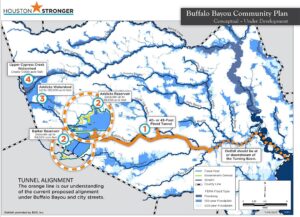 Houston Stronger has been especially active in recent weeks, engaging in key public initiatives. This includes the launch of the Buffalo Bayou Community Plan, submitting detailed comments for the U.S. Army Corps of Engineers’ Barker and Addicks Reservoir Master Plan update, and advocating for the proposed 4.879 cent tax rate to enhance the Harris County Flood Control District’s ability to maintain aging infrastructure.
Houston Stronger has been especially active in recent weeks, engaging in key public initiatives. This includes the launch of the Buffalo Bayou Community Plan, submitting detailed comments for the U.S. Army Corps of Engineers’ Barker and Addicks Reservoir Master Plan update, and advocating for the proposed 4.879 cent tax rate to enhance the Harris County Flood Control District’s ability to maintain aging infrastructure.
 Over the month of September Houston Stronger has conducted a series of presentation on the Buffalo Bayou Community Plan. This project has been in the works for the past few years and serves as a comprehensive initiative designed to enhance flood resilience in the region, particularly in response to the devastating impacts of Hurricane Harvey in 2017. The plan comprises several key components, including the construction of a 40 or 45-foot diameter tunnel that will channel floodwaters from the Barker and Addicks Reservoirs toward the Houston Ship Channel/Galveston Bay. This infrastructure is vital for significantly increasing flood protection for neighborhoods on both sides of the tunnel, ultimately reducing the risk of catastrophic flooding during extreme weather events. In addition to the tunnel, the plan proposes three other components. Increasing storage capacity ±58,000 acre-feet of storage within the Addicks Reservoir and ±94,000 acre-feet of additional storage capacity within the Barker Reservoir (for a potential total of 152,000 acre-feet). The dredge material from the excavations can be used to reinforce the aging levees, and to create new topography within the reservoirs adding new ecological and recreational value while reducing transportation costs related to the disposal of the dredge material. These efforts aim to enhance both environmental and recreational value while ensuring community support and avoiding adverse environmental impacts.
Over the month of September Houston Stronger has conducted a series of presentation on the Buffalo Bayou Community Plan. This project has been in the works for the past few years and serves as a comprehensive initiative designed to enhance flood resilience in the region, particularly in response to the devastating impacts of Hurricane Harvey in 2017. The plan comprises several key components, including the construction of a 40 or 45-foot diameter tunnel that will channel floodwaters from the Barker and Addicks Reservoirs toward the Houston Ship Channel/Galveston Bay. This infrastructure is vital for significantly increasing flood protection for neighborhoods on both sides of the tunnel, ultimately reducing the risk of catastrophic flooding during extreme weather events. In addition to the tunnel, the plan proposes three other components. Increasing storage capacity ±58,000 acre-feet of storage within the Addicks Reservoir and ±94,000 acre-feet of additional storage capacity within the Barker Reservoir (for a potential total of 152,000 acre-feet). The dredge material from the excavations can be used to reinforce the aging levees, and to create new topography within the reservoirs adding new ecological and recreational value while reducing transportation costs related to the disposal of the dredge material. These efforts aim to enhance both environmental and recreational value while ensuring community support and avoiding adverse environmental impacts.
Upper Addicks Watershed Retention, aka component 3, calls for up to 100,000 acre‐feet of added storage, using berms for medium‐size retention basins south of Cypress Creek and creek-side retention along South Mayde and Bear Creeks to help contain the Cypress Creek Overflow. Located in the upper Cypress Creek Watershed, Component 4 calls for 17,000 acre‐feet of added storage created through land acquisition and restoration. These efforts will provide positive impacts for both Addicks Reservoir and the mid- and lower-reaches of Cypress Creek. By addressing flood management holistically and involving a diverse group of stakeholders, the Buffalo Bayou Community Plan seeks to foster long-term sustainability and resilience for the Buffalo Bayou watershed and surrounding communities.
Additionally, the Houston Stronger Technical Committee and Expert Advisors, under the leadership of Chair Guy Hagstette and Vice-Chair Mary Anne Piacentini with specialty support from Chuck Stilwell, put together comments submitted by Houston Stronger on September 16th regarding the USACE Master Plan Update for the Addicks and Barker Reservoirs. Comments focus on changing conditions and lessons learned since the plan was put into place 15 years ago. “Houston Stronger recommends that the updated master plan should include, as a goal, consistent emphasis on innovative strategies that advance the primary authorized purpose of the reservoirs: Flood Damage Reduction.” This includes that the update should allow for terrain modifications to increase flood control capacity.
 Houston Stronger is advocating for increased investment in the Harris County Flood Control District (HCFCD) to address critical maintenance needs. Following the recent unanimous approval by Harris County Commissioners Court, Houston Strogner believes that expanding funding for HCFCD is essential to support vital infrastructure repairs, including sediment removal, erosion control, and concrete replacements within its channel network.
Houston Stronger is advocating for increased investment in the Harris County Flood Control District (HCFCD) to address critical maintenance needs. Following the recent unanimous approval by Harris County Commissioners Court, Houston Strogner believes that expanding funding for HCFCD is essential to support vital infrastructure repairs, including sediment removal, erosion control, and concrete replacements within its channel network.
Over the past 25 years, HCFCD’s maintenance budget has remained stagnant, even as its flood control infrastructure portfolio has more than doubled. This lack of sustained investment has resulted in decades of deferred maintenance and aging systems throughout Harris County. Despite these challenges, HCFCD has made notable progress in reducing flood risk for thousands of residents, with billions invested in new projects that are already delivering tangible results—with much more to come. If approved, Proposition A would create an additional $100 million for the Flood Control District’s maintenance budget. This would bring the Flood Control District’s total maintenance budget to $241 million.
Looking forward to the 2025 legislative session, Houston Stronger will be supporting efforts to increase funding for the Flood Infrastructure Fund and statewide regional flood planning efforts.
